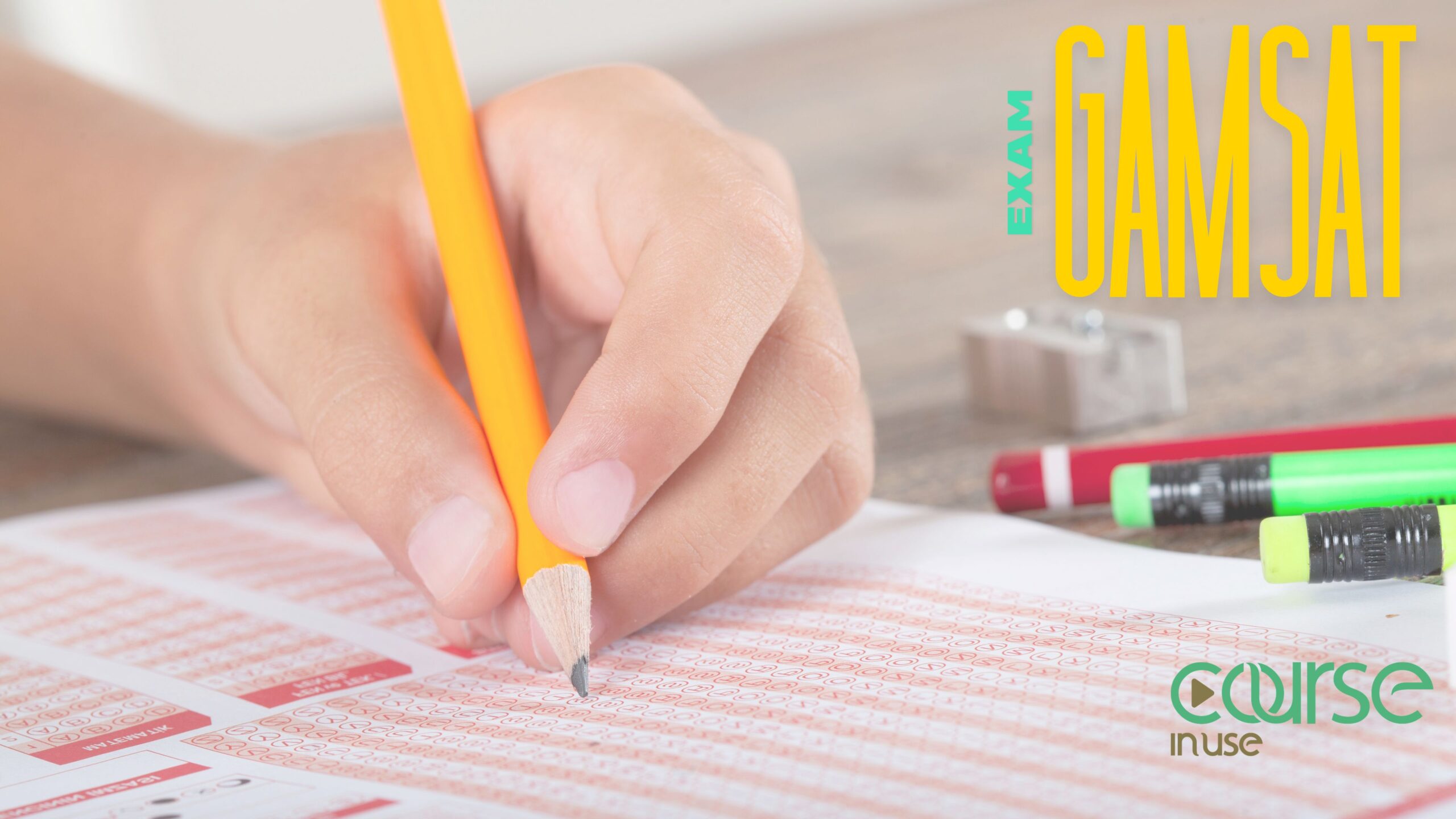What is the GAMSAT exam?
The GAMSAT exam (Graduate Medical School Admissions Test) is a standardized test used in the admissions process for graduate-entry programs in medicine, dentistry, optometry, physiotherapy, podiatry, pharmacy, and veterinary science in Australia, Ireland, and the UK.
What is the purpose of the GAMSAT?
The purpose of the GAMSAT (Graduate Medical School Admissions Test) is to assess the academic aptitude and reasoning skills of candidates applying to graduate-entry programs in various healthcare professions, including medicine, dentistry, optometry, physiotherapy, podiatry, pharmacy, and veterinary science. The exam aims to:
1. Evaluate Academic Ability: Assess the ability of candidates to comprehend and apply scientific and academic concepts essential for advanced study in healthcare fields.
2. Assess Problem-Solving Skills: Evaluate critical thinking, problem-solving, and analytical reasoning skills necessary for success in demanding graduate-level programs.
3. Standardize Admissions: Provide a standardized assessment tool that allows universities in Australia, Ireland, and the UK to compare candidates fairly based on their academic readiness and cognitive abilities.
4. Predict Success in Graduate Programs: Help predict the likelihood of candidates performing well in the rigorous academic environment of graduate-entry healthcare programs.
5. Support Fair Selection: Ensure that admissions decisions are based on merit and academic potential, promoting fairness and transparency in the selection process.
Overall, the GAMSAT serves as a crucial component of the admissions process for graduate-entry healthcare programs, ensuring that admitted students are well-prepared academically and intellectually for the challenges of professional education in healthcare.
What is the structure of the GAMSAT?
The structure of the GAMSAT (Graduate Medical School Admissions Test) exam typically consists of three main sections. Here is an overview of its structure:
1. Section 1: Reasoning in Humanities and Social Sciences
Content: This section assesses the ability to understand and analyze concepts in humanities and social sciences, including ethics, philosophy, cultural studies, and psychology.
o Format: Multiple-choice questions (MCQs) and comprehension tasks.
o Skills Tested: Critical thinking, analytical reasoning, and interpretation of written and visual data.
2. Section 2: Written Communication
o Content: Candidates are required to produce two essays based on the prompts provided.
o Format: Essay writing.
o Skills Tested: Written communication, logical structure of arguments, clarity of expression, and persuasive writing.
3. Section 3: Reasoning in Biological and Physical Sciences
o Content: This section evaluates knowledge and application of concepts in biology, chemistry, and physics at the undergraduate level.
o Format: Multiple-choice questions (MCQs).
o Skills Tested: Scientific reasoning, problem-solving abilities, and understanding of scientific principles
Overall Exam Format:
• The GAMSAT is a full-day test typically lasting around 5.5 to 6 hours.
• Sections 1 and 2 are completed in the morning session, with a break in between.
• Section 3 is conducted in the afternoon session.
• Scores are reported as scaled scores for each section, which are combined to form an overall GAMSAT score.
This structure ensures that the GAMSAT evaluates a wide range of skills and knowledge necessary for success in graduate-entry programs in medicine and related health professions.
The GAMSAT scoring system:
The GAMSAT exam consists of three distinct sections, each evaluated separately. You will receive a score for each section, which is later converted into an overall GAMSAT score. Your overall score is a result of the weighted average of the scores obtained in these three sections.
It is worth mentioning that in the GAMSAT exam, each of the four scores is expressed on a scale from 0 to 100, which are not percentage marks.
1. Conversion to Scaled Scores:
Raw scores from each section are then converted to scaled scores. This conversion process adjusts for any differences in difficulty between different versions of the test.
Scaled scores typically range differently for each section based on the overall performance of test-takers.
2. Overall GAMSAT Score:
After converting the raw scores to scaled scores, the three section scores are combined to calculate an overall GAMSAT score.
The overall score ranges from 0 to 1000, though the exact range and scaling may vary from year to year.
3. Percentile Rank:
Along with the overall score, candidates receive a percentile rank. This percentile rank indicates how their performance compares to other candidates who took the test. For instance, a percentile rank of 80% means the candidate performed better than 80% of all test-takers.
4. Usage of Scores:
GAMSAT scores are used by universities in Australia, Ireland, and the UK as part of their admissions criteria for graduate-entry programs in medicine, dentistry, and other health professions.
Different universities may have specific score requirements or preferences for each section or the overall score, depending on the program and competition level.
Overall, the GAMSAT scoring system aims to provide a standardized evaluation of candidates’ academic abilities, reasoning skills, and preparedness for advanced study in health-related fields
Format of the GAMSAT
Section 1 consists of 75 multiple-choice questions to be completed in 100 minutes.
Section 2 requires two essays to be written within 60 minutes.
Section 3 comprises 110 multiple-choice questions to be completed in 170 minutes.
The number of questions in each section and the time to answer them
Section 1 – Reasoning in Humanities and Social Sciences:
• Number of Questions: Typically around 75 questions.
• Time Allotted: 100 minutes.
Section 2 – Written Communication:
• Number of Questions: Consists of 2 essay tasks.
• Time Allotted: 60 minutes.
Section 3 – Reasoning in Biological and Physical Sciences:
• Number of Questions: Generally around 110 questions.
• Time Allotted: 170 minutes.
Registration and Test Dates
• Test Administration: Twice a year, in March and September.
• Registration Periods: Typically opens a few months before the test date.
March Test: Registration opens in December.
September Test: Registration opens in May.
Fees:
Standard registration fee: AUD 549.
Late registration fee: Additional AUD 110.
Test Dates:
March Test: Section II on 31 August – 1 September; Sections I and III on 13 or 15 September (varies by location).
September Test: Similar schedule with precise dates announced on the official website.
GAMSAT Registration Process
To register for the GAMSAT exam, you need to follow these steps:
1. Register for the GAMSAT exam on the ACER website:
– Create a GAMSAT account.
– Pay the registration fee.
– Registrations open in November for the March GAMSAT and in May for the September GAMSAT.
– Note that you need to choose your preferred test location and date from the available options.
2. Prepare for the GAMSAT exam:
– Review the test format, content, and scoring method.
– Note that the exam is conducted in a digital format and lasts for 5.5 hours.
3. Sit the GAMSAT exam:
– Attend the exam at your chosen date and location.
– Required documents to bring:
a) GAMSAT ID.
b) Photo identification.
– Note that after completing the exam, a confirmation email will be sent to you.
4. Receive your GAMSAT results:
– Results are typically released about two months after the exam.
– You can view your results online through your GAMSAT account.
– Your results will include your overall score and scores for each section.
– Note that your exam results are valid for two years.
5. Apply to medical schools:
– You can apply either directly or through GEMSAS.
– GEMSAS (Graduate Entry Medical School Admissions System) is a centralized application service that allows you to apply to multiple medical schools in Australia with one online application.
– Documents required for application:
– Academic Transcripts: Transcripts and records of undergraduate and any higher education.
– GAMSAT Results: Your GAMSAT scores, including overall and section scores.
– Curriculum Vitae (CV: Including educational, work, and volunteer experience.
– Personal Statement: Explaining your reasons and motivation for entering the medical field.
– Letters of Recommendation: From university professors or employers attesting to your abilities and qualifications.
– Proof of English Proficiency: If your native language is not English, you may need to provide a language proficiency certificate like IELTS or TOEFL.
– Application Form: The online application form is submitted through GEMSAS or the medical schools’ websites.
– Application Fee: Payment of application fees, which may vary by university.
– Supporting Documents: Additional documents that may be requested by the universities, such as evidence of research activities, certificates from specialized courses, etc.
– Note that the required documents and criteria may vary depending on the university and program. Therefore, it is best to carefully review the guidelines and requirements of each university before submitting your application.
6. Attend interviews and receive offers from medical schools:
– If you are selected for an interview, you will be notified by the medical schools or GEMSAS.
– Interviews are typically conducted between July and November.
– Note that interview formats and criteria may vary; during the interview, your motivation, communication skills, ethical reasoning, and suitability for medicine will be assessed.
– Note that after accepting and receiving offers from medical schools, you must accept or decline the offers within the specified time frame.
List of universities that accept students through the GAMSAT exam.
In Australia
• For Medical Degree Programs
– Australian National University
– Deakin University
– Flinders University
– Griffith University
– Macquarie University
– The University of Melbourne
– University of Notre Dame Australia (Fremantle and Sydney)
– The University of Queensland
– The University of Sydney
– The University of Western Australia
– The University of Wollongong
– University of Tasmania
• For Dental 4-Year Graduate-Entry Programs
– The University of Melbourne
– The University of Queensland
– The University of Sydney
– The University of Western Australia
• For 4-Year Doctor of Optometry
– The University of Melbourne
• For 2-Year Master of Pharmacy
– The University of Sydney
Course In Use website is the best Comprehensive resources for learning international online courses and preparing for international exams.




